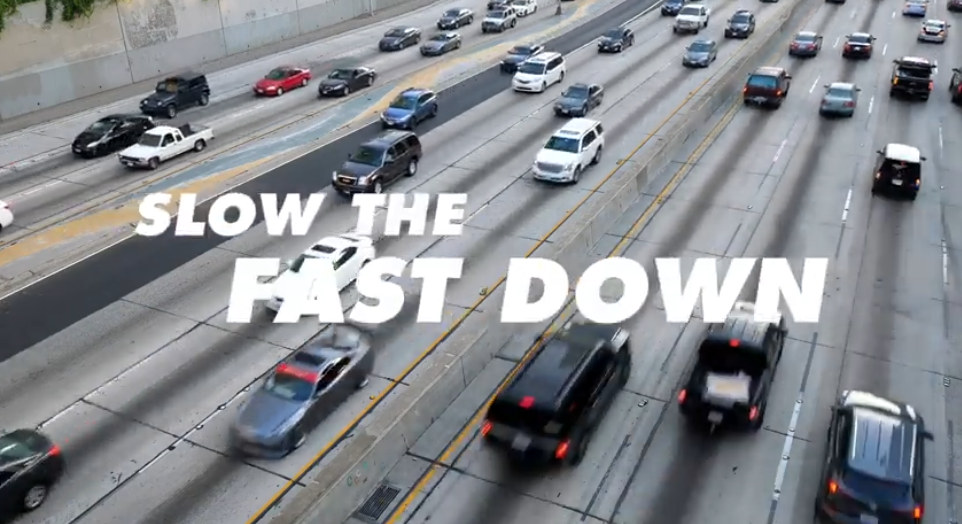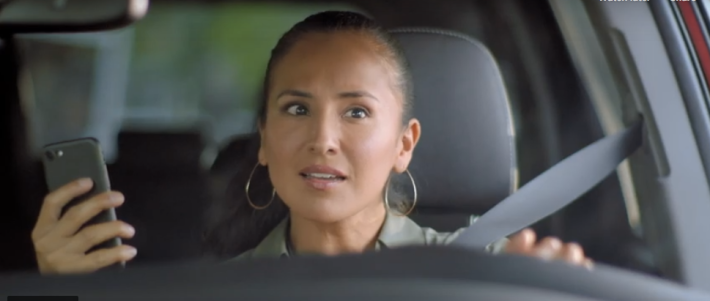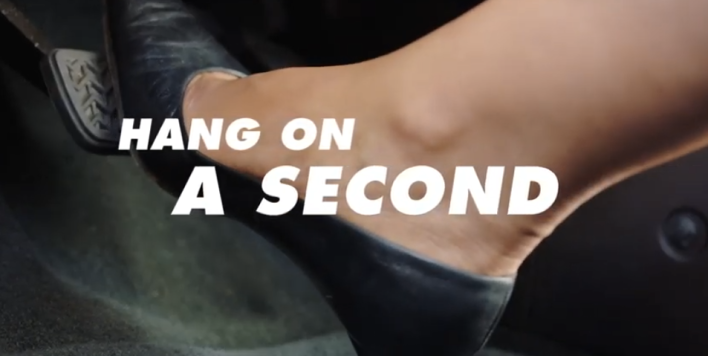Note: GJEL Accident Attorneys regularly sponsors coverage on Streetsblog San Francisco and Streetsblog California. Unless noted in the story, GJEL Accident Attorneys is not consulted for the content or editorial direction of the sponsored content.
The California Office of Traffic Safety (OTS) has launched a public relations campaign focused on convincing speeding drivers to slow down. Three short videos are coming soon to a TV program, social media app, or maybe a billboard near you.
Two fifteen-second spots appeal to drivers who are "on the go" to slow down a bit. And one 30-second ad goes a tiny bit deeper, showing a woman looking at a phone while she's driving, and appealing to her to take a look outside and really see the people she's about to run over.
OTS is also working to make yard signs available to remind drivers to slow down.
Media campaigns have their place, I guess. It's a big lift to try to shift a culture that celebrates speeding and bad driving via car commercials and movies, and at least the state government is trying to get the message out there that speeding is a problem. But in trying to appeal to drivers, this campaign falls into the trap of normalizing the really bad behavior that makes streets so dangerous.
The campaign is notable, though, because it is the first time the OTS has focused specifically on speeding. Speeding has always been a problem - despite lobbying efforts to deny it is a major factor in crashes - but since COVID shutdowns have emptied highways that are built to encourage fast driving, it has gotten worse. The CHP reports that it issued more than double the number of speeding citations in the early months of the shutdown as the same period a year before - and those are just the ones who got caught. In addition, rising fatalities despite lower traffic volumes have been blamed on riskier behavior, including excessive speeding.
The primary job of the OTS is funneling federal grants to programs and projects that make streets and highways safer. Its priority areas include impaired and distracted driving, protection of car occupants, bike and pedestrian safety, motorcycle safety, and enforcement. A recent round of grants allocated $93.7 million for 400 projects run by government agencies, nonprofits, and educational institutions.
Those grants include supporting the Complete Streets Assessment program at UC Berkeley's SafeTREC center, which teaches community members and local governments to conduct walk safety audits, evaluate factors that contribute to dangerous traffic conditions, and formulate plans for fixing them. They also include grants to cities and nonprofits creating their own safety campaigns and educational programs, such as Pasadena and Culver City.
The official announcements of these grants tend to include a generic, uninformative list of how they will be applied, a comment that applies equally to another set of OTS grants that go to police departments for enforcement activities around specific rules.
The enforcement grants focused on pedestrian and bike safety, every year, are dismayingly generic, and seem to imply that police are striving to write an equal number of tickets to drivers, bicyclists, and pedestrians, despite the huge differences in consequences and circumstances for each. That is, roads are designed for cars, and bike riders and pedestrians are expected to fit themselves around cars and stay out of their way, but are orders of magnitude more vulnerable to injury if a driver breaks a rule.
The city of Berkeley, for example, took some heat for ticketing people biking along quiet Bicycle Boulevards who failed to completely stop at a stop sign, even when there was no other traffic present - possibly just to fill the quota for ticketing cyclists under the terms of its OTS grant. The police were not concerned about what could be outsized consequences for the bike riders, including high fines, court dates, and totally losing interest in riding a bike, just when communities are trying to get more people using sustainable modes of travel.
Ongoing conversations around how to eliminate profiling, and how to move traffic enforcement away from armed police, could force a few other cities to shift from this "check-the-box" approach to grant funding. That would be beneficial, and could even lead to a more rational approach to the use of enforcement as a means of changing behavior. Currently the NHTSA, which funds the OTS grants, requires very little in return for the grants, other than reporting a few general data points such as number of tickets issued.
However, according to OTS Public Information Officer Timothy Weisberg, enforcement is still where they see the most potential for creating behavioral change. "When it comes to speeding," Weisberg told Streetsblog, "most people - based on surveys we've done - after they get a ticket for speeding are more likely to change their behavior."
Speed feedback signs can also be effective, either because people don't realize they are speeding or because they think that a sign flashing at them could mean they are about to get a ticket.
Speed cameras and speed limiters on cars could be even more powerful deterrents to speeding, but they are outside the range of what OTS can do. Speed cameras, at least, need first to be legalized in California. Over the last several legislative sessions attempts to do so have been beaten back by police unions and the CHP. It remains to be seen if 2021 is the year it can finally happen.
Meanwhile, this PR campaign is no more than a tiny beginning.
"This is a small way to reach people," said Weisberg. "That's the hope - to change behaviors. The message is simple, it's just getting people to do it."








